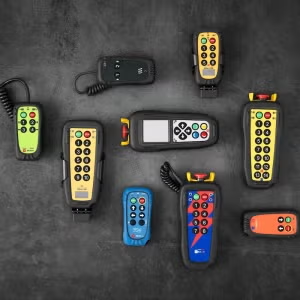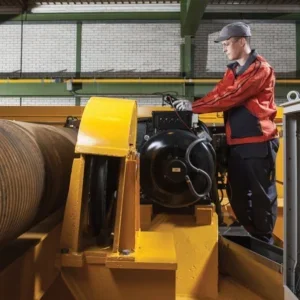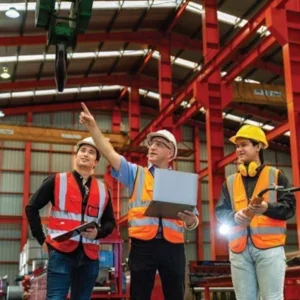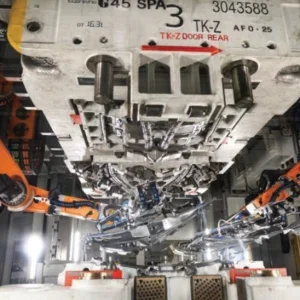Having explored the installation of overhead lifting equipment in existing facilities, Myra Pinkham explains why putting a crane in a new building represents its own challenges.
Generally speaking installing cranes in newly constructed buildings or expansions is less problematic than doing so in existing facilities, where it could disrupt business activities. This is especially true, crane suppliers say, when they have early input into the design of the facility where they are installing their cranes.
 Demand for cranes in new, ‘greenfield’ facilities remains surprisingly brisk in North America despite the current economic downturn (some say recession) in the United States.
Demand for cranes in new, ‘greenfield’ facilities remains surprisingly brisk in North America despite the current economic downturn (some say recession) in the United States.
It would be expected that this economic slowdown would affect not just the United States, but Canada as well. As Wayne Davis, general manager of O’Brien Installations Ltd., Stoney Creek, Ontario, points out, it has often been said: “If the United States gets a cold, Canada gets the sniffles.” But despite that, he describes Canadian demand for cranes, including for new facilities, as “holding its own” and even being “pretty buoyant.”
He says that while activity from automakers, especially the Detroit Three, hasn’t been very strong, there are other industries that are still very busy including steel fabrication, glass processing, wastewater treatment and infrastructure construction. “Also there is a lot of business relating to mining in northern Ontario as well as business relating to power generation – including co-generation, waste to energy and nuclear energy – throughout Canada.”
As a result, “there is a fair amount of new construction,” even by the New Domestic (formerly known as transplant) automakers, says Davis, observing that Toyota, for example, has been adding new facilities in North America, including both an assembly plant and a stamping plant in Ontario.
Even in the United States demand for new installations have remained strong, says John Kennedy, general manager for Konecranes Inc., Springfield, Ohio. “Actually I don’t think a lot has changed in the past six to 12 months. Business has remained surprisingly solid, probably because the shrinking US dollar has resulted in a decline of import penetration and has also driven more international demand for US manufacturers’ products. As a result, there is still a fair amount of new construction in the United States.”
 He declares: “Energy has been strong – both conventional and alternative. For example, there has been, and is expected to continue to be, a surge in wind turbines. A number of manufacturing plants are being built to support that industry, including plants making blades and towers.”
He declares: “Energy has been strong – both conventional and alternative. For example, there has been, and is expected to continue to be, a surge in wind turbines. A number of manufacturing plants are being built to support that industry, including plants making blades and towers.”
Some other areas of strength, according to Joe DiCesare, vice president of Florida Handling Systems Inc., Bartow, are the steel industry, as well as the pre-cast concrete and fertilizer industries. In the steel industry, observes Mitch Green, service advisor for Proserv Crane & Equipment, Irving, Texas, it is not just the mills, but also the service centers and processors that are spending a lot of money on capital expenditures.
There is also a decent amount of business revolving around the military, observes Dick Milligan, president of Overhead Handling Systems, Pinehurst, North Carolina, including manufacturing related to the new MRAP (mine resistant ambush protected) vehicle.
A lot of power issues in the United States has also created demand for new crane installations, says Dennis Bethel, president of Atlanta Crane & Automated Handling, Ballground, Georgia, but he maintains that much of the new construction in the United States – which he says is strongest in the power, auto and steel industries – is not necessarily coming from domestic manufacturers, but more from foreign companies building plants in the United States. One prime example of that is a huge carbon and stainless steel mill currently being constructed by Germany’s ThyssenKrupp AG in Calvert City, Alabama, although it is also seen with several new facilities being built, or planned to be built, by New Domestic automakers, as well, including Toyota, Honda, Volkswagen and Kia.
Most crane manufacturers see the strength of installations in greenfield buildings continuing. “We keep being told that business will slow, but I see it keeping up,” says Bethel. It might “slip a little” due to the downward pressure that rising steel prices is having on the industry, says Carlo Lonardi, vice president of sales and marketing for Harrington Hoists, Manheim, Pennsylvania, but it will continue to be strong nevertheless.
So, when do crane suppliers become involved with these new construction projects? There is no one clear answer. Sometimes it is during the building planning stage. Sometimes it is not until the building or building expansion is already erected.
“A lot depends on how savvy a customer is,” says Kennedy, maintaining, “customers should partner with crane suppliers before they start building their facilities so that they can take into account the weight, dimensional and other constraints.”
 Al Romig, sales manager, North America for Demag Cranes & Components, Houston agrees, stating: “We recommend that customers try to get as far along in the selection/consideration of a crane before getting too involved with the planning of their facility. That allows them to optimize both decisions about the crane and about the building. If they design the building before considering what crane they will buy, then they need to design the building for the most bulky, heavy crane they might consider, which could result in a waste of space and over use of steel.”
Al Romig, sales manager, North America for Demag Cranes & Components, Houston agrees, stating: “We recommend that customers try to get as far along in the selection/consideration of a crane before getting too involved with the planning of their facility. That allows them to optimize both decisions about the crane and about the building. If they design the building before considering what crane they will buy, then they need to design the building for the most bulky, heavy crane they might consider, which could result in a waste of space and over use of steel.”
But this early interaction doesn’t always occur. “We rarely consult with the customer or their general contractor prior to the building being designed. They generally don’t involve us until near the end,” says Jim Humphries, service manager for Mazzella Lifting Technologies, Cleveland. Other companies say that at least in a portion of their installations (the percentage of which varies widely company by company), they are also not consulted until later in the building process.
“Unfortunately in the United States we tend not to look at material handing in the same way as it is looked at in many countries elsewhere in the world, including in Europe and Asia,” says Bethel. “That is why, in many cases companies need to put in new cranes three or four years later. Too often the people who make decisions about cranes don’t understand cranes.”
Bethel, however, does not just blame the customer and/or its general contractor, but also the sales staff at crane manufacturers and distributors. “One of the biggest problems in our industry is that people are going away from educating customers about what’s available. They are more focused on quoting than giving customers what they really should have.”
Unfortunately, Bethel declares, “I see this getting worse, partly because the salespersons themselves are not educated about their product and the new technologies available.“
 Some other companies, however, disagree. Florida Handling Systems’ DiCesare says: “We work as a team with the customer, educating them as to what is available at their budget level. Sometimes they are not aware of new technologies that are available. The customer knows their business the best. We suggest what technologies are out there. We tell them their options.”
Some other companies, however, disagree. Florida Handling Systems’ DiCesare says: “We work as a team with the customer, educating them as to what is available at their budget level. Sometimes they are not aware of new technologies that are available. The customer knows their business the best. We suggest what technologies are out there. We tell them their options.”
Davis says that O’Brien also makes sure it educates its customers. “People tend to have preconceived notions about cranes. They know about the type of crane they used, perhaps, 25 years ago and don’t realize how many things in our industry have changed. Every year there are improvements,” he observes, adding: “A big part of our job is letting clients know what’s available. But you need to be delicate and say things like “that’s a good idea, but it isn’t the best choice in this case.”
Kennedy agrees, noting that most crane sales people are technically knowledgeable. “They don’t just sell cranes, they are applications specialists. Crane firms must point out to customers that what might have been appropriate five years ago is not necessarily the best choice today. “There are more dimensionally friendly cranes as well as cranes with more controls and features. Some of the controls have the ability to monitor the conditions of the crane, including stopping overloading,” Kennedy explains.
“A lot depends who we are dealing with,” says Humphries. “If we are working through a general contractor, they generally know what they want. But if we are working directly with the customer (the user), they usually tell us how they want to use the crane and we give them advice on how to achieve that.”
Romig agrees that there is a difference between jobs where the customer handles the entire job themselves and those that turn everything over to a general contractor: “It is a big advantage to be allowed to have a lot of early, direct contact with the owner, as that gives the crane supplier the ability to discuss what the duty cycle of the crane will be, how it will be used, for what capacities, at what travel speeds and what controls are needed. This way we can figure out what is the best crane for the owner to meet his requirements but doesn’t necessarily have the features that he doesn’t need,“ he adds.
 Bethel says the crane supplier can sometimes save customers money through this kind of evaluation – both on the cranes themselves and on the runway steel used to support the cranes. “For example, one customer had requested a 40 ton crane, but after evaluation we saw that they only needed a 30 ton crane, given that we realized during our conversation that they didn’t need to pick up anything that’s more than 27 tons. Similarly another customer had been looking at a 20 ton crane, but upon examination we realized they would be better served with two 10 ton cranes. Their manager of engineering thanks us, saying that if they had bought the 20 ton crane, they would have eventually needed another 10 ton cranes as well when two 10 ton cranes was all that they needed.”
Bethel says the crane supplier can sometimes save customers money through this kind of evaluation – both on the cranes themselves and on the runway steel used to support the cranes. “For example, one customer had requested a 40 ton crane, but after evaluation we saw that they only needed a 30 ton crane, given that we realized during our conversation that they didn’t need to pick up anything that’s more than 27 tons. Similarly another customer had been looking at a 20 ton crane, but upon examination we realized they would be better served with two 10 ton cranes. Their manager of engineering thanks us, saying that if they had bought the 20 ton crane, they would have eventually needed another 10 ton cranes as well when two 10 ton cranes was all that they needed.”
Another thing that crane suppliers can do when talking directly to the customer is get a feel not only how they will be using the crane now, but how they might use it in the future. “One thing customers tend to neglect is looking at the future, but it is very important as it is less expensive to design in a little more capacity now than redesign it later,” Konecranes’ Kennedy observes.
It tends to be different when the owner turns the job over to a general contractor, he says, explaining that general contractors tend to take a different approach to equipment purchases than owners do. “The general contractor tends to award bids based mainly on price. The low price wins,” Romig explains. “It doesn’t mean that contractors are bad people, it is just they don’t have the incentive to consider what is going to happen as far as 20 to 25 years down the road, which is how long the average crane lasts.”
Some crane suppliers have tried to bridge this divergence by offering more turnkey services. DiCesare says that Florida Handling Systems actually has its own general contracting division, allowing the crane manufacturer to provide both the building and cranes in about half of the cases. But even when dealing with general contractors chosen by their customers, he says, the company is often consulted on the buildings themselves. “Many general contractors realize that is critical.”
That is how it worked with a recent 65,000 expansion of steel service center Infra-Metals Co.’s Tampa, Florida, facility that included two 15 ton dual hoist cranes. John Walmsley, the southern region marketing manager of the steel distributor, says that while this went through a general contractor (Florida Handling was responsible for the original building and the cranes contained within about eight years ago), the crane manufacturer was involved at the beginning of the engineering stage. “That was very helpful. The job went very smoothly. They made it very seamless for us,” he says.
While some people say that installing cranes in new builds is easier than doing so in existing buildings (while others say it isn’t easier, just different), there are still certain challenges that are pretty much universally acknowledged, according to the crane suppliers. One challenge is access to the building, especially if people are already moving other equipment into the building, says Proserv’s Green. Mazzella’s Humphries agrees, observing that sometimes the hours are limited. “They might not be working nights and weekends and there could be limited delivery and/or working hours. Also weather could play havoc, especially if the building isn’t completed yet.”
Another biggie, he says, is coordinating work with the other trades there. “Plumbers, electricians and other contractors might be working in the same bay and there are sometimes scheduling problems.”
As part of that coordination effort, Bethel says, “it is not just important to ensure that our cranes are delivered on time, but also to know how the building schedule is proceeding. We need to ensure that our cranes are not just sitting around if there is a building delay.” Likewise, Humphries says if they are running ahead of schedule you might need to get the crane delivered quicker than anticipated.
This is one reason that a turnkey operation is sometimes easier, D’Cesare says. “We know what trades are there and when. We try to make sure everyone works together and not on top of each other. But when it is coordinated by a company’s general contractor, we go by their schedule.”
At times there might also be changes in the original plans for the building, says Humphries. “It doesn’t happen often, but it could be major if it happens and causes us to make judgment calls.”
He says “more than often new construction goes fairly well – better than installing cranes in existing operations – especially if we have access to the entire bay and if the bay, floors, ceiling, etc are in good condition.”






